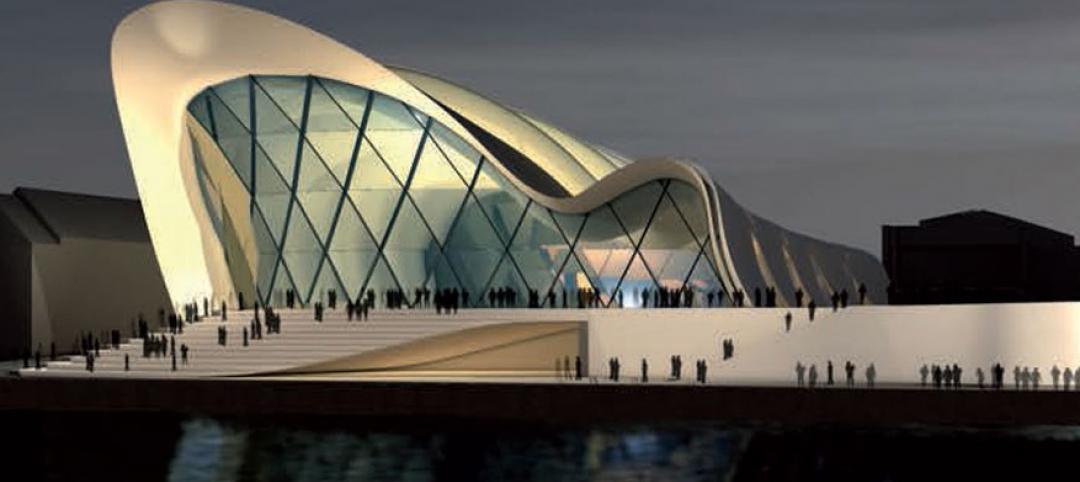Whether you agree with Frank Lloyd Wright’s definition of good architecture or not, the late architect was never anything less than resolute and unswerving in his convictions. If ever you needed evidence of this, look no further than PBS Digital and Quoted Studios’ Blank on Blank animated short featuring excerpts from an interview between Wright and Mike Wallace in 1957.
In the short six-minute video, Wright calls architecture of the past 500 years “phony,” says, if given another 15 years to work, he would rebuild the country and change the nation, and casts aspersions on the New York City skyline calling it a “great monument to money and greed.” Wright certainly doesn’t hold anything back in this interview, but before anyone gets any ideas to call him arrogant, he has a few choice words for you too. “I think any man who really has faith in himself will be dubbed arrogant by his fellows,” Wright says. “I think that’s what happened to me.”
Wright’s interview on The Mike Wallace Show took place when he was 90 years old, just two years before his death. At this point in his life, Wright had designed over 1,000 buildings and had seen over 500 of them come to fruition, but even with so much work under his belt, Father Time was the only thing slowing the 90-year-old architect down and hindering him from accomplishing more.
Returning to his idea of changing the country, Wallace quoted Wright as previously saying, “If I had another 15 years to work, I could rebuild this entire country. I could change the nation.” Wright confirmed that he said this saying, “It’s amazing what I could do for this country. I wouldn’t start to change so much the way we live, as what we live in and how we live in it.”
Wright wasn’t the only architect featured in a Blank on Blank video. A 1965 interview between architect Buckminster Fuller and Studs Terkel was also turned into an episode.
Fuller’s interview isn’t quite as provocative as Wright’s, but he shares some of the same ideas as Wright regarding the current state of architecture. “I saw that the way in which we built was very, very ignorant,” Fuller says.
The rest of the video gives some insight into how and why Fuller developed his architectural style and philosophy.
Both videos act as windows into the minds and imaginations of two architects with very unique and very ambitious ideas for what architecture could and should be.
According to Quoted Studios, its purpose in creating these animated videos from interviews, such as this one featuring Wright and Wallace, is to unlock hidden stories. “Whether they’re interviews sitting on a journalist’s tapes or in a major archive, recordings buried in a media brand’s archives, or the yet to be heard stories within an organization, we transform raw, intimate storytelling into culturally resonant digital content,” the company writes on its website.
Other notable figures featured in the Blank on Blank series include Rod Serling, Ayn Rand, Ray Bradbury, and Carl Sagan.
Related Stories
| Nov 14, 2014
Bjarke Ingels unveils master plan for Smithsonian's south mall campus
The centerpiece of the proposed plan is the revitalization of the iconic Smithsonian castle.
| Nov 14, 2014
Haskell acquires FreemanWhite, strengthens healthcare design-build business
The combination expands Haskell’s geographic presence by adding FreemanWhite’s offices in Chicago, Charlotte, Nashville, and San Diego. FreemanWhite will retain its name and brand.
| Nov 14, 2014
What college students want in their living spaces
In a recent workshop with 62 college students, architects from Little explored the changing habits and preferences of today's students, and how those changes affect their living spaces.
| Nov 14, 2014
JetBlue opens Gensler-designed International Concourse at JFK
The 175,000-sf extension includes the conversion of three existing gates to international swing gates, and the addition of three new international swing gates.
Sponsored | | Nov 12, 2014
Eye-popping façade highlights renovation, addition at Chaffin Junior High School
The new distinctive main entrance accentuates the public face of the school with an aluminum tube “baguette” system.
| Nov 12, 2014
Collaboration as competitive advantage
A collaborative planning and design process may seem like a common-sense goal, but the concept can be a challenge to achieve in the fragmented AEC industry. SPONSORED BLOG
Sponsored | | Nov 12, 2014
Williams Scotsman plugs into the jobsite
Many of our customers conduct important business from their temporary modular jobsite office and most require access to technology to get their job done effectively and efficiently. SPONSORED CONTENT
| Nov 12, 2014
Chesapeake Bay Foundation completes uber-green Brock Environmental Center, targets Living Building certification
More than a decade after opening its groundbreaking Philip Merrill Environmental Center, the group is back at it with a structure designed to be net-zero water, net-zero energy, and net-zero waste.
| Nov 12, 2014
Refocusing the shifted line
A recent trend in the practice of architecture that I’ve been noticing is the blurring of responsibility between design and construction coordination. I’m not sure why this trend began, but the subject is worth exploring, writes FXFOWLE's Mark Nusbaum.
| Nov 12, 2014
Designs by three finalists for new Beethoven concert hall unveiled
David Chipperfield and Valentiny are among the finalists for a new concert hall being built to commemorate Beethoven’s 250th birthday in his hometown of Bonn, Germany.

















